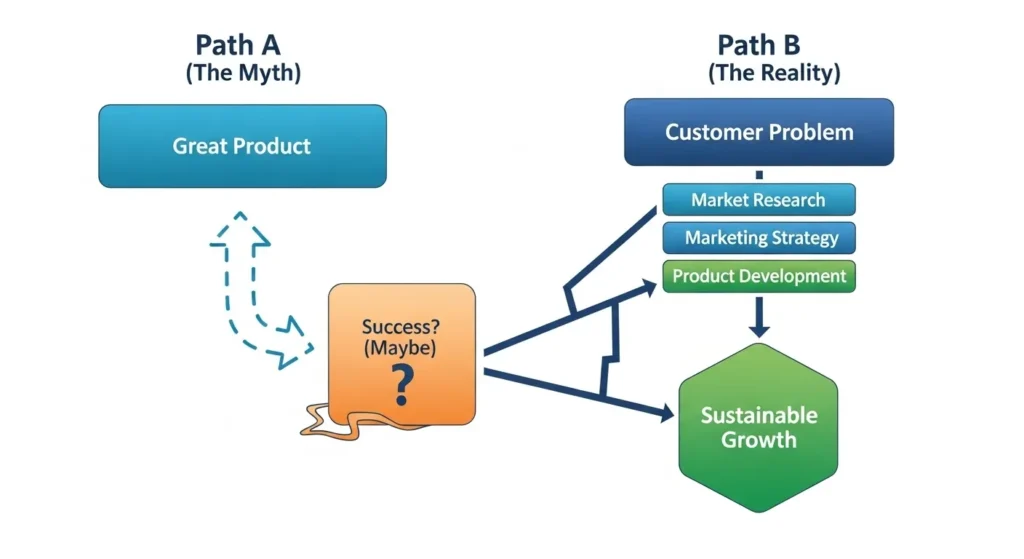The “Build It and They Will Come” Myth – Why Great Products Don’t Guarantee Startup Success
Pain Points This Article Addresses
- Startups burning through investment money on product development while ignoring marketing
- Entrepreneurs believing a great product automatically creates customer demand
- Founders watching superior products fail while inferior competitors thrive
- Small businesses stuck in the trap of perfecting features nobody asked for
- Confusing user experience with customer acquisition strategy
- Missing revenue targets despite having products that should resonate with the market
The $1.75 Billion Quibi Disaster: When Great Products Meet the Build It Myth
In April 2020, Hollywood veterans Jeffrey Katzenberg and Meg Whitman launched Quibi with $1.75 billion in funding. They had everything: A-list celebrities, premium content, revolutionary technology that switched between portrait and landscape viewing. They built an incredible product.
Six months later, they shut down.
Why? Because they believed the Field of Dreams fallacy: “If you build it, they will come.” They spent billions on content, millions on technology, but almost nothing on understanding if anyone actually wanted 10-minute premium videos on their phones. They built it. Nobody came.
This isn’t unique to Quibi. It’s the startup graveyard’s most common tombstone inscription.
The Build It Fallacy: How the Myth Destroys Startups
Where This Costly Marketing Myth Started
The phrase comes from the 1989 movie Field of Dreams, where Kevin Costner builds a baseball diamond in his Iowa cornfield after hearing voices. In Hollywood magic, legendary players appear and crowds follow.
Silicon Valley turned this fiction into business advice. The myth spread like wildfire because it appeals to every founder’s ego: focus on your brilliant product, and customers will magically appear. No messy marketing. No talking to customers. Just pure creation.

Why Great Products Fail Without Marketing Strategy
Let’s look at the brutal reality of amazing products that died because nobody knew they existed:
| Product | What Made It Great | Investment Lost | Why It Failed |
|---|---|---|---|
| Segway | Revolutionary personal transport, self-balancing technology | $100+ million | No clear customer base, relied on product to sell itself |
| Google Glass | Cutting-edge AR technology, hands-free computing | $1+ billion | Built features without understanding customer needs or privacy concerns |
| Microsoft Zune | Better features than iPod, wireless sharing, bigger screen | $500+ million | Late to market, no marketing strategy to differentiate |
| Betamax | Superior video quality to VHS | Billions (Sony) | Ignored marketplace dynamics, focused on product perfection |
| WebTV | Internet on your TV in 1996 | $425 million | Built for a problem customers didn’t know they had |
Each had superior technology. Each believed quality would win. Each failed because building a product without a customer acquisition plan is like opening a restaurant in the desert and expecting a lunch rush.
The Strategic Reality: Why Marketing Beats Product Every Time
Case Study: How Inferior Products Dominate Through Marketing
VHS vs Betamax: The Marketing Master Class
Sony’s Betamax was objectively better. Superior picture quality, smaller cassettes, better build. But JVC’s VHS won. Why?
JVC understood that great product means nothing without distribution. While Sony perfected pixels, JVC:
- Partnered with every manufacturer who’d listen
- Made their technology open-source
- Focused on longer recording times (what customers actually wanted)
- Built strategic alliances with video rental stores
Result: VHS captured 70% of the market despite being technically inferior. The lesson? Marketing strategy beats product quality when you’re starting a business.
Dropbox vs Every Other Cloud Storage
When Dropbox launched, dozens of cloud storage services existed. Many had better features, more storage, enterprise tools. But Dropbox had something better: a marketing strategy that actually worked.
Their referral program was genius. Free storage for invites. Simple UX that your grandmother could understand. A waiting list that created urgency. They didn’t build the best product and wait. They built a good-enough product or service and marketed brilliantly.
Today Dropbox is worth $8 billion. Most competitors from 2008? Dead.

The Truth About Customer Adoption
Many startups fall into the trap of thinking customers care about features. They don’t. Here’s what actually drives adoption:
- Solving Real Pain Points (Not Imaginary Ones) – Segway thought people had a walking problem. People didn’t think they had a walking problem. No pain points, no purchase.
Visibility Before Quality – You can’t buy what you don’t know exists. The best product and service in the world generates zero revenue if nobody knows about it.
Social Proof Over Features – Customers don’t buy the best new product. They buy what others are buying. That’s why inferior products with better marketing win.
Why Your Startup Will Fail Without Marketing From Day One
The Myth of the Perfect Launch
Entrepreneurs love to perfect their product before launch. “Just one more feature.” “Let’s enhance the user experience.” “We need seamless integration.”
Meanwhile, competitors are eating your lunch with worse products and better marketing.
The Webvan Warning
Webvan raised $800 million to revolutionize grocery delivery. They built massive automated warehouses, developed proprietary technology, created the perfect user journey. They spent 18 months perfecting everything before launch.
They went bankrupt in 2001.
Twenty years later, Instacart does the same thing with contractors and existing stores. No infrastructure. No perfection. Just smart marketing and rapid iteration based on customer feedback. Valuation: $39 billion.
The Strategic Marketing Framework That Actually Works
Instead of building in isolation, successful startups follow this pattern:
Week 1-4: Market Validation (Not Product Building)
- Talk to 100 potential customers
- Identify actual pain points (not what you think they are)
- Test messaging that resonates
- Understand the competitive marketplace
Week 5-8: Build Minimum Viable Product
- Prioritize features that solve identified problems
- Ignore nice-to-have features
- Focus on one core value proposition
Week 9-12: Marketing Before Launch
- Build email list of potential customers
- Create content around the problem (not your solution)
- Establish social proof through early adopter testimonials
- Plan your customer acquisition funnel
Day One Launch: Already Have Customers Instead of launching to crickets, you launch to an audience that’s waiting.
The Heretic’s Guide to Building and Marketing Together
Stop Building, Start Selling
The biggest trap founders fall into? Hiding behind product development because marketing is scary. Building features is comfortable. Talking to customers is not.
Here’s the harsh truth: Your product will never be perfect. But imperfect products with great marketing make millions while perfect products die in obscurity. If you hate marketing and if you hate selling – you need to think about taking on a partner or a key team member who lives for marketing and selling.
The Airbnb Reality Check
When Brian Chesky and Joe Gebbia started Airbnb, their “product” was air mattresses on their apartment floor. No app. No seamless booking. No intuitive interface. Just a basic website and a problem to solve: hotel rooms were expensive and scarce during conferences.
Instead of building the perfect platform, they:
- Went door-to-door recruiting hosts
- Posted on Craigslist (hijacking their traffic)
- Attended every event where travelers gathered
- Created fake demand by booking their own properties
They focused on marketing and customer acquisition while competitors built “better” platforms. Today Airbnb is worth $75 billion. Their technically superior competitors? Gone.

The Build-Market Balance Formula
For every hour you spend on product development, spend two on:
- Customer research
- Competitor analysis
- Content creation
- Network building
- Strategic partnerships
- Testing marketing channels
This 1:2 ratio ensures you’re not building in a vacuum. You’re building what the market actually wants while simultaneously creating demand.
Learning From the Graveyard: Products That Should Have Won
The Cautionary Tales Nobody Talks About
Friendster: First to Market, First to Die
Friendster launched in 2002, before Facebook, before MySpace. They had the great product. They had first-mover advantage. They had 115 million users.
They died because they focused on features instead of user experience and marketing. While they perfected their algorithm, Facebook focused on growth hacking and viral marketing.
The bottom line: Being first means nothing. Being best means nothing. Being known means everything.
TiVo: The Word That Became a Verb But Not a Business
TiVo revolutionized how we watch TV. The product was so good it became a verb. But despite having the best technology, they lost to cable company DVRs.
Why? Cable companies had distribution. TiVo had a great product nobody understood how to buy. They spent millions on product, pennies on educating the market. Many companies make this misstep: assuming customers understand your value proposition.
The Success Pattern: Marketing-First Companies
Look at companies that succeeded with inferior products but superior marketing:
Dollar Shave Club
- Product: Regular razors in a box
- Marketing: Viral video that cost $4,500
- Result: Sold to Unilever for $1 billion
Beats by Dre
- Product: Mediocre headphones (ask any audiophile)
- Marketing: Celebrity endorsements and lifestyle branding
- Result: Sold to Apple for $3 billion
Tesla’s Early Days
- Product: Lotus chassis with batteries
- Marketing: Elon Musk’s personal brand and vision storytelling
- Result: Most valuable car company in the world
None had the best product. All had the best marketing strategy.
Your 30-Day Anti-Build It Marketing Action Plan
Week 1: Customer Discovery (Stop Building)
- Interview 25 potential customers about their problems
- Join 5 online communities where your customers hang out
- Analyze 10 competitors’ marketing strategies
- Document actual pain points, not assumed ones
Week 2: Message Testing
- Create 10 different ways to describe your solution
- Test each message on different audience segments
- Track which resonates most (engagement, not likes)
- Refine based on customer feedback
Week 3: Build Marketing Infrastructure
- Set up email capture on a landing page
- Create content calendar for next 90 days
- Identify 3 strategic partners or local businesses to collaborate with
- Build your first 100-person email list
Week 4: Pre-Launch Campaign
- Share behind-the-scenes content about your journey
- Get 10 beta users committed before building
- Create visibility through guest posts or podcasts
- Plan launch with existing audience, not hope

The Questions Every Entrepreneur Must Face
“But Shouldn’t Product Quality Come First?”
Quality matters… to a point. But perfect products don’t guarantee success. The market is littered with superior products nobody bought.
Your minimum viable product needs to be good enough to solve the problem. Then marketing takes over. You can enhance quality once you have revenue. You can’t enhance a dead startup.
“What If I Don’t Know How to Market?”
Neither did Brian Chesky. Neither did Mark Zuckerberg initially. They learned because they had to. If you can build a product, you can learn marketing.
Start simple:
- Talk to customers daily
- Share your journey online
- Partner with people who have audiences
- Test everything, assume nothing
- Take on a partner or team members who do know
The biggest fallacy? Thinking marketing is separate from building a business. It’s not. It IS the business.
“How Much Should I Spend on Marketing vs Product?”
Wrong question. The right question: “How can I validate demand before building?”
Smart startups spend:
- 20% on initial product
- 40% on marketing and customer acquisition
- 40% on iteration based on feedback
This ratio shifts once you achieve product-market fit. But until then, marketing isn’t an expense. It’s survival.
The Uncomfortable Truth About Building It
The “build it and they will come” myth persists because it’s comfortable. Building is fun. Coding is safe. Perfecting features feels productive.
Marketing is scary. Rejection hurts. Customers might hate what you built. But here’s the thing: They’ll hate it anyway if they never know it exists.
Every hour you spend perfecting your product in secret is an hour your competitor spends acquiring customers with their inferior solution. Guess who wins?
Summary: Pain Points Solved, Myths Shattered, Success Strategized
Pain Points We’ve Addressed:
- Burning investment on product while ignoring marketing? Use the 1:2 build-to-market ratio
- Believing great products create demand? They don’t – marketing does
- Watching inferior competitors thrive? They understand visibility beats quality
- Stuck perfecting features? Ship now, perfect later based on customer feedback
- Confusing UX with customer acquisition? They’re different skills, both essential
- Missing revenue targets? You built for imaginary customers, not real ones
The Business Heretic’s Truth:
The Field of Dreams belongs in Iowa cornfields, not in startup strategy. “If you build it, they will come” is Hollywood fiction that’s killed more businesses than any recession.
Real success comes from building WITH the market, not FOR it. Marketing isn’t something you do after building. It’s something you do instead of building the wrong thing.
Stop hiding behind product development. Start selling something imperfect to someone real. Because the only thing worse than launching too early is launching too late to a market that’s already moved on.
—————
Ready to build a business that customers actually find?
Sign up for my newsletter and be informed about my upcoming eBook on this topic. It will reveal the complete “Market-First Methodology” – a proven system for validating demand, building strategic marketing into your product DNA, and launching to customers who are already waiting.
You’ll get templates for customer discovery, marketing automation frameworks, and real case studies of products that succeeded through marketing, not features.
Because the best product in the world means nothing if nobody knows it exists.
[NEWSLETTER SIGNUP BUTTON]
No spam. No Hollywood fantasies. Just battle-tested business advice delivered weekly. Unsubscribe anytime.




